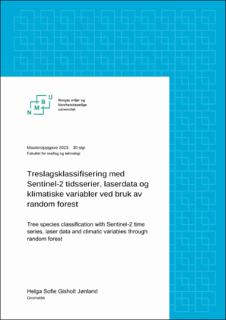| dc.contributor.advisor | Ivar Maalen-Johansen (hovedveileder) | |
| dc.contributor.advisor | Johannes Breidenbach (biveileder) | |
| dc.contributor.advisor | Dagrun Aarsten (biveileder) | |
| dc.contributor.author | Jønland, Helga Sofie Gisholt | |
| dc.date.accessioned | 2023-07-22T16:27:16Z | |
| dc.date.available | 2023-07-22T16:27:16Z | |
| dc.date.issued | 2023 | |
| dc.identifier | no.nmbu:wiseflow:6839543:54591948 | |
| dc.identifier.uri | https://hdl.handle.net/11250/3080931 | |
| dc.description.abstract | Formålet med dette oppgaven er å se på mulighetene for å bruke multispektrale satellittbilder fra Sentinel-2, klimatiske variabler og laserdata for å skille gråor og eik fra andre løvtrær og ulike granarter fra hverandre. Klassifiseringsmuligheter er undersøkt med random forest, og fremgangsmetoden er basert på norsk skogsinventar fra Landsskogstakseringen. Oppgaven vil ta for seg virkningen av områdeavgrensninger for klassifisering, utjevning av observasjonsantall for ulike treslag, og en variabelanalyse.
Oppgaven presenterer en lovende modell for å skille ulike typer granarter for et begrenset geografisk område, og to mindre presise RF-klassifiseringsmodeller for deteksjon av eik og gråor blant løvtreslag. Felles for alle modellene er viktigheten av klimatiske variabler og NDVI for løvtreslagsklassifiseringene, og liten forbedring i klassifiseringene ved tilførsel av laserdata. | |
| dc.description.abstract | The motivation behind this thesis is to explore the possibility for using multispectral satellite images from Sentinel-2, climatic variables, and laser data to identify oak and grey elder within deciduous tree species and differences between types of spruce. Classification is explored with the machine learning algorithm random forest, and the method is based on the Norwegian forest inventory data. Impact of narrowing down search areas in modelling, equalization of observation count between tree species and variable analysis will be analyzed in this paper.
This thesis presents a promising model for classification of different spruce species for a restricted geographical area, and two less precise RF classification models for detection of oak and grey elder among deciduous trees. Climatic variables were important in classification for all models and no NDVI were important in deciduous classification. No models improved significantly after adding laser variables. | |
| dc.language | nob | |
| dc.publisher | Norwegian University of Life Sciences | |
| dc.title | Treslagsklassifisering med Sentinel-2 tidsserier, laserdata og klimatiske variabler ved bruk av random forest | |
| dc.type | Master thesis | |
